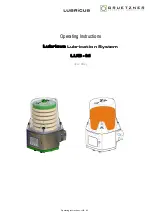
Page 5
After drilling, remove all sharp edges and make sure the surroundings
of the sink are cooled before mounting the faucet.
Step 3
Step 4
Determine desired location for the RO faucet on your sink and place
a piece of masking tape over where the hole is to be drilled. Mark the
center of the hole on the tape.
Step 1
Using a variable speed drill set on the slowest speed, drill a 1/8“ pilot
hole through both porcelain and metal casing of sink at the marked
center of the desired location. Use lubricating oil or liquid soap to keep
the drill bit cool (If drill bit gets hot it may cause the porcelain to crack
or chip).
Using a 1
¼
” diamond tip hole saw, proceed to drill the large hole. Keep
drill speed on the slowest speed and use lubricating oil or liquid soap
to keep the hole saw cool during cutting.
Step 2
Counter Top / Porcelain & Stainless Steel Sink
Note:
Most sinks are pre drilled with 1 ¼” diameter hole that you can use for your RO faucet.
(If you are already using it for a sprayer or soap dispenser, see step 1)
Porcelain sinks are extremely hard and can crack or chip easily.
Use extreme caution when drilling. Watts accepts no responsibility for
damage resulting from the installation of faucet. Diamond tip bit recommended.
Marble Counter-top
We recommend contacting a qualified contractor for drilling a hole in a
marble counter-top.
Drill a Hole for the Reverse Osmosis Faucet
How to use the Quick Connect Fittings
To make a connection, the tube is simply pushed into the fitting. The unique locking system holds the tube firmly in place
without deforming it or restricting flow. Use the steps below in reference to any quick connect tube connections.
It is essential that the outside diameter be free of score
marks and that burrs and sharp edges be removed before
inserting into fitting.
Fitting grips before it seals. Ensure tube is pushed into
the tube stop.
Push the tube into the fitting, to the tube stop. The collet
(gripper) has stainless steel teeth which hold the tube
firmly in position while the O-ring provides a permanent
leak proof seal.
Pull on the tube to check that it is secure. It is a good practice
to test the system prior to leaving site and /or before use.
To disconnect, ensure the system is
depressurized before removing the tube. Push in the col
-
lect squarely against face of fitting. With the collet held
in this position, the tube can be removed. The fitting can
then be reused.





































